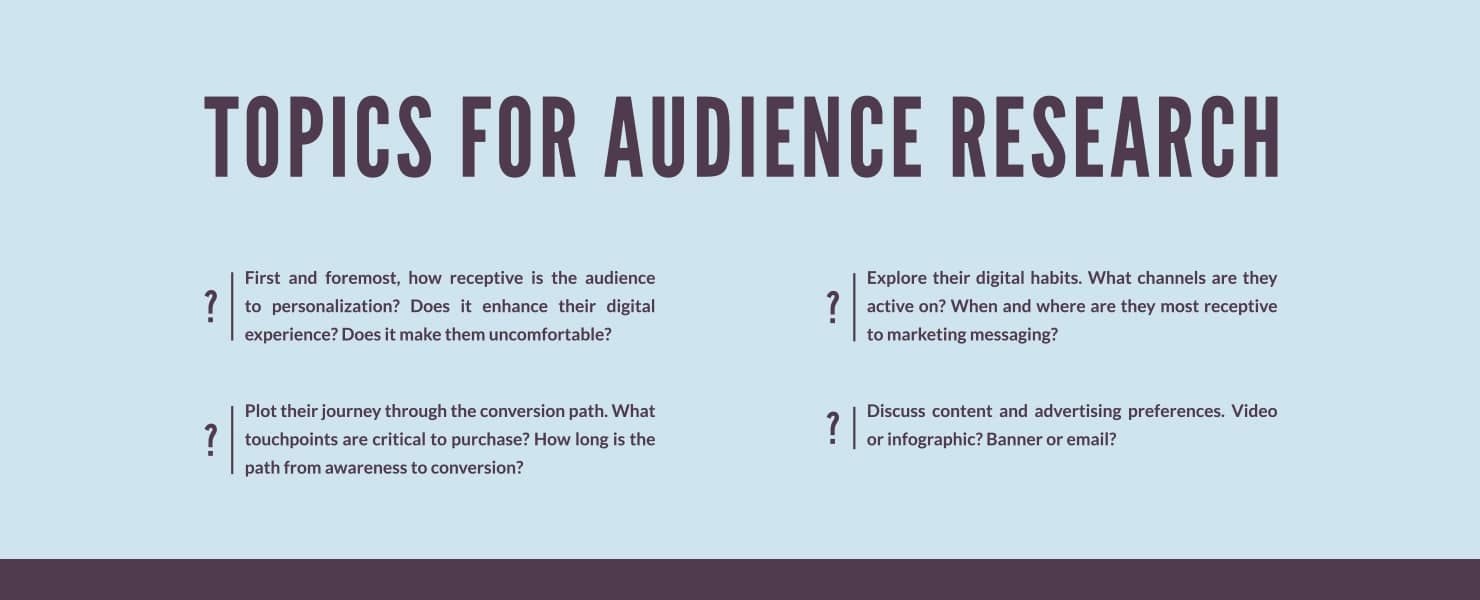A Beginner’s Guide to Research-Based Personalization

Formulating the steps to content personalization, much like the process itself, felt very daunting. There is so much potential in personalization, it’s easy to look to the penultimate execution – the far end of the continuum – a dynamic website that displays widgets and content specific to the traits of an individual visitor.
But personalization is a scalable process, start small. Think, custom email greeting before dynamic website content. Begin with the foundational steps laid out in this article, and the process becomes much more manageable.
Know Your Audience
Digital personalization, like any marketing tactic, begins with a thorough understanding of the audience. The learnings from this process will inform the personas and provide the parameters of personalization, which channels to target, the type of content to publish, frequency of delivery, tone and messaging.
1. Define Your Target Audience
Don’t think about it in a vacuum, open this discussion to other stakeholders and reach out to other teams – marketing, operations, customer service and sales.
Utilize available data to inform the discussion – web analytics, leads or purchase data.
Use this process to put parameters in place to narrow the focus and segment the target audience.
2. Understand Your Target Audience
With a broad definition of the target audience in place, take time and speak with a sample of members of the audience. Deploy surveys, host focus groups or one-on-one interviews, with the goal of understanding the target audience’s relationship with content and industry.
Consider the following topics for audience research:
- First and foremost, how receptive is the audience to personalization? Does it enhance their digital experience? Does it make them uncomfortable?
- Plot their journey through the conversion path. What touchpoints are critical to purchase? How long is the path from awareness to conversion?
- Explore their digital habits. What channels are they active on? When and where are they most receptive to marketing messaging?
- Discuss content and advertising preferences. Video or infographic? Banner or email?
3. Create Personas and Journey Maps
Take the key learnings from audience research and build behaviorally-based personas. Focus less on the demographics, but instead on the behavioral differences amongst the audience segments. Look for distinctions in the needs, conversion paths, content preferences and challenges.
Construct profiles and map the conversion journey for each distinct audience group. This work becomes instrumental in making personalization decisions about how to customize content and build one-to-one marketing relationships.
Strategy
Take the insights from the audience exploration and marketing objectives to create an empirically-backed personalization strategy by following the steps outlined below.
5. Identify Personalization Opportunities
Look for opportunities to deliver meaningful personalization. Use insights from personas and the audience research to match meaningful content (addressing needs and challenges) to the right user at the right time.
For example, if one segment of users has a challenge with the cost of services, look for opportunities to provide sales or promotional offers to that group.
Or imagine an industry with high variability in customer knowledge around the services. Serve baseline educational content to the low knowledge group and more technical and thought-leadership content to the high-knowledge group.
6. Define Personalization and Triggers
The next step involves operationally defining the personalization opportunities. This work outlines the channel(s) for personalization, trigger behavior and addresses any technical requirements.
Use the audience insights and marketing objectives to determine which channels to target (e.g. email, remarketing display, social ads or website CMS.)
Work with the development team, or the content platform directly, to determine any technical constraints and, more importantly, the type of tracked data that can be used for a trigger (the user trait or behavior that prompts personalization). Examples of trigger data could include user profile data (name, title, gender), referral source data, or previous site behavior (pages consumed, widgets clicked, events/goals completed).
The triggers should be matched to the journey map touchpoints. For example, abandoned cart behavior could trigger personalized promotional offer email or website content.
Execute & Beyond
With a strategy in place, go forward into an ongoing phase on execution, measure and optimize.
Personalization is not static. Continually monitor the performance of personalization strategy using consumer analytics data to inform on-going optimization.
